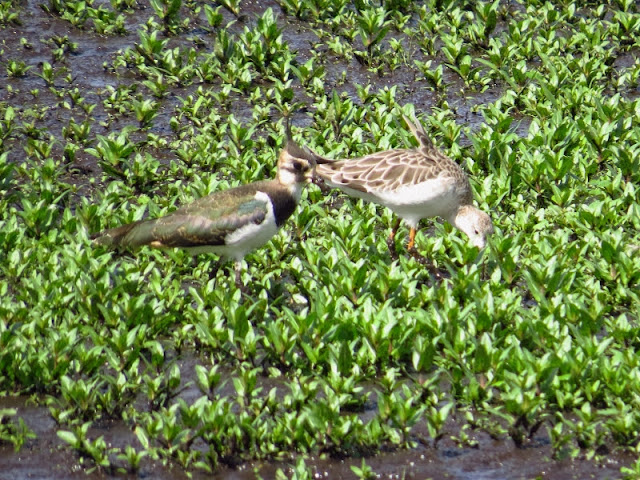Covid restrictions mean that pre-booking is essential. Apart from pens containing geese and ducks (and flamingo's) from around the world there are walks to hides and blinds to view an extensive area of managed wetland full of ducks, waders and gulls. There are geese, though at this time of year only the usual feral Greylags and Canadas.
They have managed to open most of the hides using a one way-system and with a strict limit on numbers. The doors are fixed open as are some of the windows to maintain social distancing. Masks are required inside the hides. In practice these restrictions seemed to have little impact on my ability to view the from the hides. Most visitors stay around the pens, the children's play area or the cafe and shop.
Apart from innumerable Mallard waiting to be fed many of the birds are at some distance. A telescope would be handy but not essential.
There is also a reed bed walk. This was very quiet with the Sedge and Reed Warblers having mostly gone and the Reed Buntings now stopped singing. It was far too breezy for a chance to hear (let alone see) any Bearded Tits.
My log for a four-hour visit was
Birds (44 species seen + 1 heard)
Mute Swan
Pink-footed Goose (injured)
Greylag Goose
Canada Goose
Shelduck
Gadwall
Teal
Mallard
Shoveler
Tufted Duck
Cormorant
Grey Heron
Little Grebe
Great Crested Grebe
Marsh Harrier
Common Buzzard
(Common) Kestrel
Moorhen
Coot
Lapwing
Black-tailed Godwit
Ruff
Green Sandpiper
Greenshank
(Common) Redshank
Snipe
Black-headed Gull
Lesser Black-backed Gull
Feral / Racing Pigeon
Stock Dove
Wood Pigeon
Collared Dove (H)
Jackdaw
Carrion Crow
Blue Tit
Great Tit
Barn Swallow
House Martin
Long-tailed Tit
Chiffchaff
Wren
Starling
Robin
Greenfinch
Goldfinch
Small White (Pieris rapae)
Green-veined White (Pieris napi)
Speckled Wood (Pararge aegeria)
Small Heath (Coenonympha pamphilus)
Red Admiral (Vanessa atalanta)
Peacock (Aglais io)
Small Tortoiseshell (Aglais urticae)
Honey Bee (Apis mellifera)
Buff-tailed Bumblebee (Bombus terrestris)
Common Wasp (Paravespula vulgaris)
Marmalade Hoverfly (Episyrphus balteatus)
Tapered Drone-fly (Eristalis pertinax)
The Footballer (Helophilus pendulus)
Syrphus sp.
Brown Hawker (Aeshna grandis)
Common Blue Damselfly (Enallagma cyathigerum)
Blue-tailed Damselfly (Ischnura elegans)
Common Darter (Sympetrum striolatum)
Common Frog (Rana temporaria)
Just a few images
There were hundreds of Lapwings. This is an adult judging by the length of the crest. It has just completed a post-breeding moult and the new feathers all have pale tips. On a juvenile the feathers would look more scalloped.
Talking of scalloped feathers this Ruff was the best bird of the day for me. The feathers look large and typically seem loose and are inclined to blow about in the wind. A rather leggy-looking wader with yellow-orange legs and a short bill. Looks small-headed.
Here is the Ruff alongside a Lapwing. The Ruff is so pale I suspect it is a juvenile. It is likely a male – they are larger than females. This bird seemed to have a problem with one wing – it is more than just the breeze blowing the feathers I feel.
A typical view from one of the hides. Lots of Lapwings and Black-headed Gulls. There seems to be four juvenile Black-headed Gulls at the very back, three together towards the left and one to the right. Otherwise they all seem to be adults in winter plumage. Perhaps I should start calling the youngsters 'first-winter' now, but it is still only August.Green-veined White (Pieris napi)
Speckled Wood (Pararge aegeria)
Small Heath (Coenonympha pamphilus)
Red Admiral (Vanessa atalanta)
Peacock (Aglais io)
Small Tortoiseshell (Aglais urticae)
Honey Bee (Apis mellifera)
Buff-tailed Bumblebee (Bombus terrestris)
Common Wasp (Paravespula vulgaris)
Marmalade Hoverfly (Episyrphus balteatus)
Tapered Drone-fly (Eristalis pertinax)
The Footballer (Helophilus pendulus)
Syrphus sp.
Brown Hawker (Aeshna grandis)
Common Blue Damselfly (Enallagma cyathigerum)
Blue-tailed Damselfly (Ischnura elegans)
Common Darter (Sympetrum striolatum)
Common Frog (Rana temporaria)
Just a few images
There were hundreds of Lapwings. This is an adult judging by the length of the crest. It has just completed a post-breeding moult and the new feathers all have pale tips. On a juvenile the feathers would look more scalloped.
Talking of scalloped feathers this Ruff was the best bird of the day for me. The feathers look large and typically seem loose and are inclined to blow about in the wind. A rather leggy-looking wader with yellow-orange legs and a short bill. Looks small-headed.
Here is the Ruff alongside a Lapwing. The Ruff is so pale I suspect it is a juvenile. It is likely a male – they are larger than females. This bird seemed to have a problem with one wing – it is more than just the breeze blowing the feathers I feel.
(Ed Wilson)



